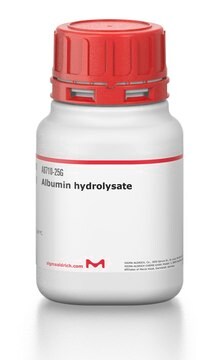H1641
Hanks′ Balanced Salt Solution 10x
Without sodium bicarbonate, 10 ×, liquid, sterile-filtered, suitable for cell culture
Synonym(s):
Hanks’ Balanced Salt solution
Sign Into View Organizational & Contract Pricing
All Photos(1)
About This Item
UNSPSC Code:
12352207
NACRES:
NA.75
Recommended Products
Quality Level
sterility
sterile-filtered
form
liquid
concentration
10 ×
technique(s)
cell culture | mammalian: suitable
impurities
endotoxin, tested
Looking for similar products? Visit Product Comparison Guide
General description
Balanced salt solution (BSS) plays an important role in cell culture as they provide a buffering system to maintain the medium within the optimum pH range (7.2-7.6). It also serves as an irrigating, transporting, and diluting agent to maintain the osmotic balance between intra- and extracellular spaces. BSS provides cells with water, inorganic ions, and energy for normal cell metabolism.
Application
Hanks′ Balanced Salt Solution 10x has been used:
- to culture cerebella slices from rats
- in Giardia duodenalis isolation
- as a component of the dissection media for the storage of corpus callosum slices from mice
Reconstitution
Supplement with 0.35 g/L sodium bicarbonate at 1×.
Storage Class Code
12 - Non Combustible Liquids
WGK
WGK 1
Flash Point(F)
Not applicable
Flash Point(C)
Not applicable
Choose from one of the most recent versions:
Already Own This Product?
Find documentation for the products that you have recently purchased in the Document Library.
Customers Also Viewed
Nora L Salaberry et al.
Brain structure & function, 224(1), 19-31 (2018-09-23)
For many years, the suprachiasmatic nucleus (SCN) was considered as the unique circadian pacemaker in the mammalian brain. Currently, it is known that other brain areas are able to oscillate in a circadian manner. However, many of them are dependent
Shenghui Liu et al.
iScience, 24(9), 103003-103003 (2021-09-11)
Recent research has indicated the adult liver Sox9+ cells located in the portal triads contribute to the physiological maintenance of liver mass and injury repair. However, the physiology and pathology regulation mechanisms of adult liver Sox9+ cells remain unknown. Here
Nora L Salaberry et al.
Molecular neurobiology, 54(7), 5327-5334 (2016-09-02)
Circadian rhythms are strongly affected by drugs. In rodents, chronic methamphetamine (METH) intake changes circadian activity rhythms, mainly by altering light synchronization that generates the expression of a free-running rhythm with a period longer than 24 h and a second behavioral
Zili Zhang et al.
Autophagy, 16(8), 1482-1505 (2019-11-05)
Ferroptosis is a recently discovered form of programmed cell death, but its regulatory mechanisms remain poorly understood. Here, we show that the RNA-binding protein ZFP36/TTP (ZFP36 ring finger protein) plays a crucial role in regulating ferroptosis in hepatic stellate cells
Victor S Van Laar et al.
Neurobiology of disease, 74, 180-193 (2014-12-06)
Disruption of the dynamic properties of mitochondria (fission, fusion, transport, degradation, and biogenesis) has been implicated in the pathogenesis of neurodegenerative disorders, including Parkinson's disease (PD). Parkin, the product of gene PARK2 whose mutation causes familial PD, has been linked
Our team of scientists has experience in all areas of research including Life Science, Material Science, Chemical Synthesis, Chromatography, Analytical and many others.
Contact Technical Service







